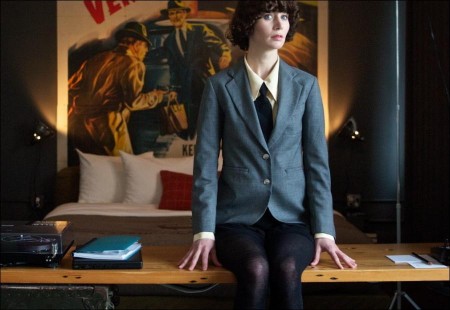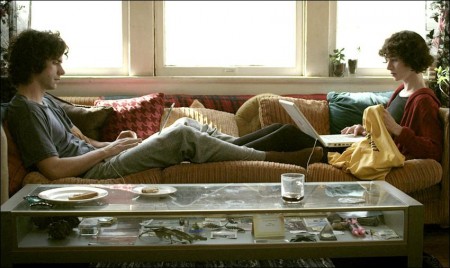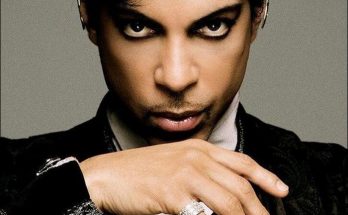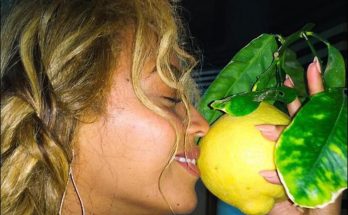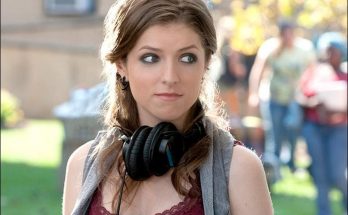In conversation with Miranda July on The Future movie. Filmmaker, actress, writer, musician, performance artist, dancer (sort of) — Miranda July is the definition of a multimedia artist. First making her mark in 1990s Portland, the young Vermont native was a constant fountain of creativity, issuing short films and spoken-word recordings, editing a ‘zine, doing a number of conceptual and performance art pieces and starting an indie-film distribution company.
Her newest picture, “The Future,” which opens in Portland on Friday, is a metaphysical drama about relationships and commitment, starring July and Hamish Linklater as a thirty-something couple experiencing crisis while awaiting the adoption of a cat called Paw Paw — an anthropomorphic, squeaky-voiced (by July) kitty pining for the love and bonding from his prospective new parents.
July has rarely visited Portland since her departure. However, in early May she turned up in town to present a program of student-made short films inspired by her work, preview “The Future” and hole up in an Ace Hotel suite and talk about directing, time, togetherness and the new reality of DIY video. This interview has been edited for clarity and length.
Where did the idea for this second film originate?
After my first feature I had no interest in making another movie immediately. I finished writing a book of short stories and then wrote a performance called Things We Don’t Understand and Definitely Are Not Going To Talk About.
Like The Future, which evolved out of it, this performance was about an affair, but the couple was played by a real couple I chose from the audience. I didn’t tour with it because ultimately it was really hair-raising to pull off each night. I’d been lucky so far, but there was so much that could go wrong. Also, I was ready to think about writing a script again and hungry to tell the story in a more intricate way.
The finished script evolved from the original concept. It became real, like the difference between Pinocchio the puppet and the real boy. Everything that was symbolic had to be fully realized. Maybe most importantly, I began to understand that the affair wasn’t about love or lust, it was her desire to flee her own dimensionality, as if it might be possible to live in 2D, or without a soul. I think this is kind of what fame seems to promise – you will be entirely lit up by other people’s gazes, and you won’t have to face the difficult task of igniting yourself ever again.
The working title for the script was Satisfaction, and yet you ended up calling the film The Future. Why did you think this was a more appropriate title, in the end, and how do you feel like the film addresses the subject of the future?
I was thinking of satisfaction in a pretty dark way, like how we never stop craving until we die. But over time the word started to feel more glib and easy than I meant it. I knew I wanted one familiar word so I did an Internet search for the most common words – the past, the present, and the future were among the search results. There is nothing more complicated and full of hopes and fears than the future. We think about it more than anything else, we never quite get there. It’s always new, but we’re always older when it happens. And the idea of a young couple’s future is so inherently fraught — but the actual practice of it, of growing old together, is pretty profound.
You have also published a book of stories and been active in the art and performance worlds. How is the process of writing a film script different from conceiving projects in these other mediums?
Writing a script is like you’re the first person in a game of telephone and you don’t want to say something in such a complicated way that it will get contorted as it’s repeated. The feelings and ideas can still be complex, but there’s not this smart narrator person who gets to say all the smart ideas, like there is in fiction. You have to demonstrate everything you want to say with the people and places and props from this particular world you’re making. You don’t get the shared experience of NOW that you have with a performance, but a gazillion people get to see it, so it’s more democratic in the end. Of course the essential task is the same in all the mediums – to express something true, to remember you are free, to make a needed space that didn’t exist before.
What led you to make the jump towards surrealism in this film? Were there any literary or artistic influences for this?
It will seem out of the blue to people who have only seen my last movie, but Me and You and Everyone We Know is actually one of the few things I’ve made that hasn’t had “unreal” elements in it. Most of my videos, short stories and performances have used abstract or slightly sci-fi elements to convey emotional states. It’s like when you’re telling a true story and you have to exaggerate because the truth doesn’t convey the depth or heights of what happened. The way that Sophie feels haunted by her former life is so piercing and real for her that it can’t just be a look on her face, it needs some real mass, it actually crawls towards her, pitifully forsaken and unrelenting.
The Internet and the way it affects human relationships are major themes in both your films. How do you deal with the struggle with “constant connectedness” faced by Sophie and Jason in The Future?
Remembering that I can exist at all without being online is a daily challenge. It’s interesting to me because it’s so new. How often is there a brand new daily challenge shared by almost every person you know? But as an artist who has always tried to find new ways to feel intimacy with the audience, it also seems useful. Part of me will always be the twenty-year-old who tried to create revolutions through fanzines and VHS tapes and the US postal service. So that girl is pretty wowed by the fact that she can write a tweet and get instant responses. And yet (and this is the thing that really dates me) I hate to do anything that might make it even harder to have long thoughts that take a long time to unravel. So I use Twitter, Facebook, and my website in my own slow way, which is not all that effective, from a networking standpoint.
A lot of online culture is about being watched and reacted to, which is something I think women and girls have a special relationship to. Teenage girls often discover their power through being looked at. If you have the usual “mom/dad didn’t really see me” issues, then it’s easy to get pretty caught up in being seen. (Type “me dancing in my room” into a YouTube search and you’ll see what I mean.) Being watched kind of takes away the burden of living; you almost don’t have to exist while you’re being watched. In the movie I kind of reverse-engineer this aspect of the Internet, bring it back to its origins. Sophie wants to make a YouTube dance before becoming responsible – essentially it is her last chance to be watched like a child. So when she can’t do it, when she’s paralyzed, this is a real crisis. She has to find another way to be watched, and she does. Only when she’s faced with a real child in need does she give up, and giving up allows her
Why did you decide to make a cat the catalyst for the dread of impending responsibility, rather than, say, a baby?
One day I was making myself write and it wasn’t working. I just felt so incapable, barely even human, much less brilliant. So I told myself “OK, write from there. What does Incapable sound like?” I wrote a long, plaintive monologue in this halting voice, without even knowing who it was. The next day there was a bizarre accident wherein our dog ran into the street, causing a car to swerve and hit a cat. My producer, Gina Kwon, was actually there when it happened. As we put the dead cat in a bag I remember saying something to her like “We must redeem this cat.” Somehow this event merged with the voice and became Paw Paw.
How close are you to the characters in your films? Do you project yourself differently in the roles you write for yourself than in those written for other actors?
Since I didn’t know who would be playing the other roles when I was writing both movies, knowing Sophie would be played by me gave me a starting point – kind of like the free spot at the center of a bingo card. I created everything around that one known point, which helped me set the tone, cast and build the world. There are moments of Sophie that feel like me, but what I most relate to is the movie as a whole. I think a completed movie, with all the music done, can be a pretty good portrait of one person. But just one character in a movie has more in common with a photo of a person than a person.
The artist struggling with personal insecurities is a recurring theme in your work – from the video art of Me and You and Everyone We Know to the dances in The Future. Is there ever a victory over the obstacles, or is the process itself the point?
The process is pretty interesting, and the victories are kind of ephemeral because it never ends. Each thing I make just brings me to the door of the next project. One could easily show the same struggle without the art-making, because it’s really just the normal struggle of living – filled with paralyzed moments, shrinking and expanding time, doubt, and breakthroughs.
But at this particular age in my life I am surrounded by very smart women who aren’t doing exactly what they wanted to do, career-wise, and now they are faced with the choice of getting pregnant and giving up, or trying to make all their dreams come true in the few years and risking not being able to get pregnant at forty. Of course it’s not this simple, but I think it can feel like this. This is not exactly my plight, but it resonates with me. Which is why Sophie is a dance teacher for toddlers, and later, after quitting to focus on her own dance, she can’t even get her old shitty job back and is demoted. (Remember this is a horror story.)
How do you see filmmaking as fitting into your overall body of work as an artist?
The plan is to keep doing all of it – writing books, making art, performing, and making movies. Usually I’m working on a few things at the same time. This means that The Future is not really the follow-up to Me and You and Everyone We Know, but rather to my book of short stories, or maybe the interactive sculpture I made for the Yokohama Biennial, The Hallway, which is very much about time. Of course I know only the most die-hard fans are going to follow this strange path, so the evolution becomes mostly a personal thing.
How did you go about casting your actors? Did you set out to cast experienced actors like Hamish Linklater, David Warshofsky and even the little girl, Isabella Acres, with non-professionals?
I worked with Jeanne McCarthy on the casting, and Hamish and David were two people we talked about from day one. I met both of them, and experienced that eerie sensation of rightness that tells you your search is over. This didn’t stop me from considering and meeting with almost every single actor in their respective age groups before finally pulling the trigger (this is why having more options is not always helpful). Casting Joe was a different story altogether.
I was doing an unrelated project wherein I called up people who were selling things in the PennySaver (classifieds newspaper) and asked if I could come interview and photograph them. Joe Putterlik was one of the many fascinating people I met through this project. Meanwhile I was writing this script which involved a man selling trees and I was trying to figure out some way for him to get inside the homes of strangers – out of his small world and in to another.
Suddenly it was obvious that he could do what I was doing. I thought maybe I could even cast all the PennySaver people to play themselves, but in the end Joe was the only one who passed the screen test. I came over with a video camera and asked him to re-enact our first meeting – he ad-libbed, came up with amazing lines, often forgot we were filming, and was relentlessly willing to try it again.
But more than that, he was an incredible person, the kind of person who inspires you to not only write him into the movie, but actually change the story in light of what he’s taught you. He made all the cards (with the dirty limericks) for his wife over the last sixty years and that is just one tiny example of his bawdy, generous, tough spirit. He died on Thanksgiving, the day after I finished the movie.
Visits: 96
